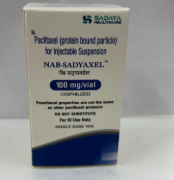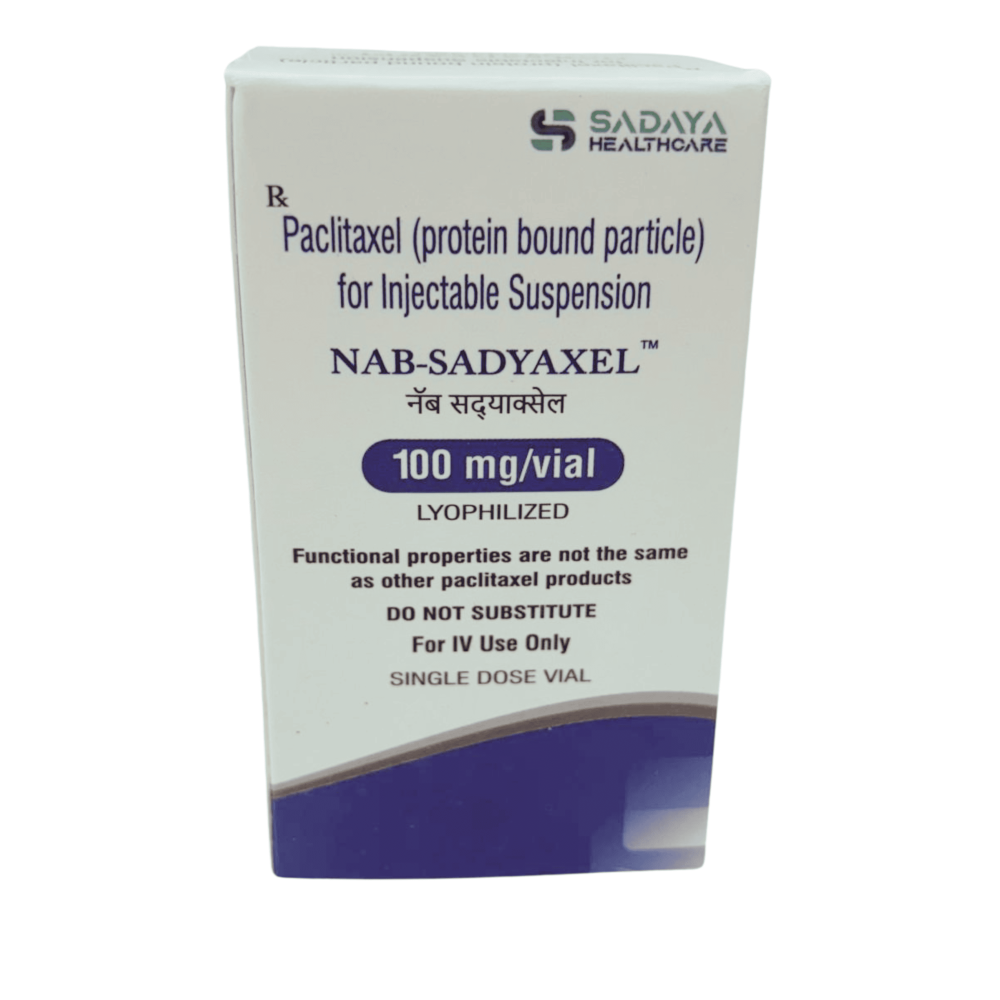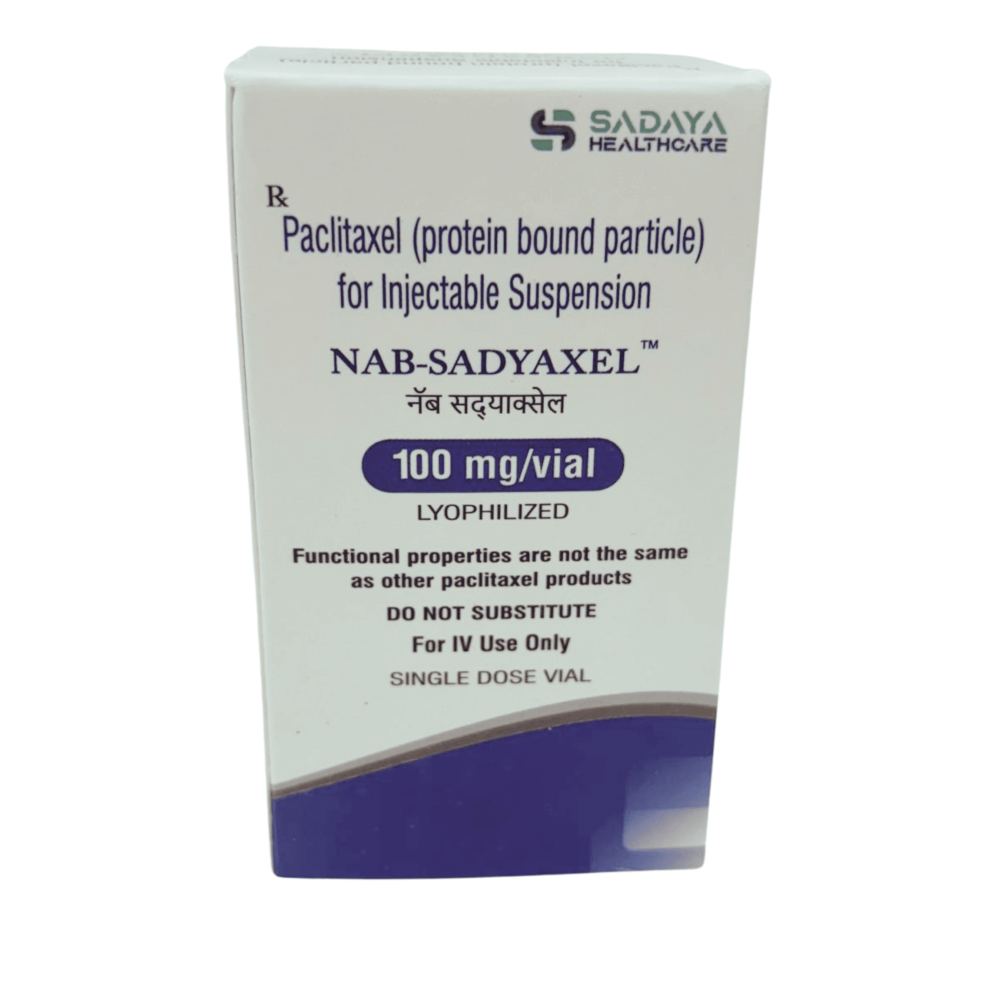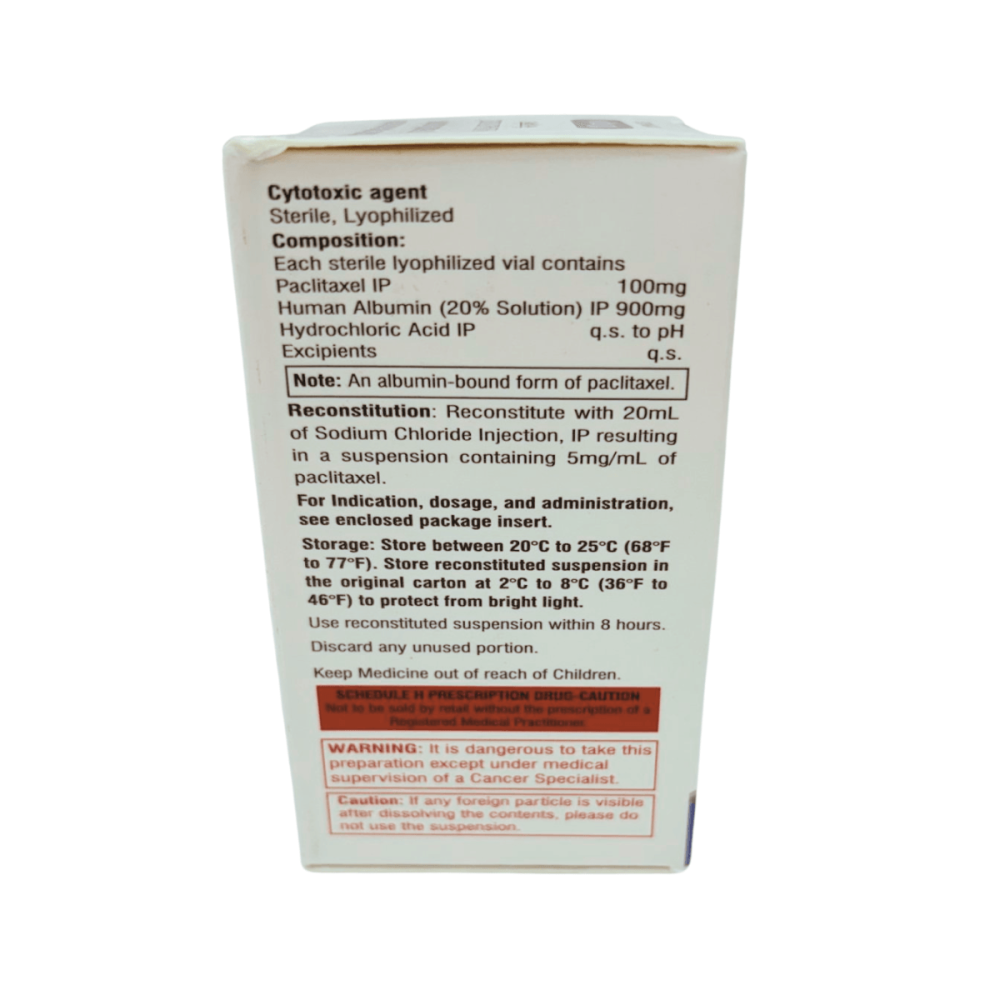
Brand name: Nab-Sadyaxel
Marketed By: Sadaya Healthcare Pvt Ltd
Strength: 100mg/vial
Packaging: Lyophilized powder containing 100 mg of paclitaxel formulated as albumin-bound
Dosage: 1.5 mg intravenous injection
Pack size: One vial/pack
Strength: 20ºC to 25ºC (68ºF to 77ºF)
For More information click here NabSadayaxelDosageInformation
FDA approved indications:
- Protein-bound paclitaxel is a chemotherapy drug.
- It is an anti-microtubule agent.
It is anti-microtubule inhibitor, mainly indicated for treatment of:
- Metastatic breast cancer, after failure of combination chemotherapy for metastatic disease or relapse within 6 months of adjuvant chemotherapy.
- Locally advanced or metastatic non-small cell lung cancer (NSCLC), as first-line treatment in combination with carboplatin, in patients who are not candidates for curative surgery or radiation therapy.
- Metastatic adenocarcinoma of the pancreas as first-line treatment, in combination with gemcitabine.
Mechanism of action:
- As Nab-paclitaxel gets injected into the bloodstream, albumin binds to GP60 receptors on endothelial cells. This GP60 facilitates the transport of nab-paclitaxel across the blood vessels into tumor tissues. It gets combined with Enhanced permeability and retention effect (EPR) and allows accumulation of drugs at tumor sites. As drug gets released into the tumor cells, nab-paclitaxel stabilizes microtubules, disrupting cell division and triggering apoptosis, thus effectively targeting and treating tumors.
Condition based dosage recommendation:
- The recommended dosage for metastatic breast cancer is 260 mg/m2 intravenously every three weeks, following combination chemotherapy failure or relapse within six months. For non-small cell lung cancer, 100 mg/m2 intravenous infusions are given on days 1, 8, and 15 of every 21-day cycle.
Warnings & Precautions:
- Patients with neutrophil count <1500 cells/mm3 should and thrombocytopenia are closely monitored and dose should be reduced subsequently in patients with either MBC or NSCLC.
- Sometimes, fatal hypersensitivity reactions including anaphylactic reactions have been reported.
- When the product is administered with gemcitabine, Pneumonitis is observed in some cases.
- Patients suffering from hepatic impairment sometimes get exposed to the toxicity of paclitaxel.
- Should not be administered to a pregnant woman as it may harm the fetus.
Common Side Effects:
- Can reduce RBC and platelet level
- Dizziness
- Diarrhoea
- Sore throat
- Numbness in hands and feet
Muscle of joint pain
Storage and Handling:
- 100 mg of paclitaxel in a single-dose vial.
- Store the vials in original cartons at 20ºC to 25ºC (68ºF to 77ºF).
- Protect from light
About Pharmacology
- Nab-paclitaxel is a chemotherapeutic drug that works by stabilizing microtubules and preventing their depolymerization, which disrupts cell division and causes cell death, particularly in rapidly dividing cancer cells. It functions similarly to paclitaxel, but with a key difference in its formulation: nab-paclitaxel is bound to albumin nanoparticles, which enhances its delivery to tumors through albumin receptor-mediated endocytosis and the Enhanced Permeability and Retention (EPR) effect. This results in better drug accumulation in tumors compared to traditional paclitaxel. Nab-paclitaxel is administered intravenously, has a wide distribution, and is metabolized in the liver. Its elimination occurs primarily through the liver, with a half-life of about 13 hours.
Important:
- Prior going for the nab-paclitaxel treatment discussion regarding the following points are to be noted and that are pregnancy status, lactation period, hepatic impairment history. During the treatment cycle of nab-paclitaxel, patients are closely administered for neutropenia that may be severe and can cause serious infections. Complete blood cell count must be performed before starting the nab-paclitaxel treatment.
Use in Specific Population
- Pediatric
- Geriatric
- Adults
- Pregnancy and Lactation
- Safety and effectiveness in pediatric patients have not been fully established. However, studies involving pediatric patients aged 1.4 to <17 years with recurrent or refractory solid tumors have been conducted. The maximum tolerated dose (MTD) adjusted for body surface area (BSA) was found to be lower in pediatric patients than in adults. No new safety concerns were identified in these pediatric studies.
- Geriatric patients aged 65 years or more were observed, where the studies showed that in such patients suffering from metastatic breast cancer diarrhea, fatigue and peripheral edema was seen. In non-small cell lung cancer, myelosuppression, tingling or numbness in hands and feet were observed to be more common. Adult females who are on nab-paclitaxel treatment are advised to avoid becoming pregnant for at least six months after the last dose of nab-paclitaxel.
- Drug associated risks are not available in human data while in animal studies it was found that nab-paclitaxel is harmful for fetuses, also lactating women are advised not to breastfeed if they are on nab-paclitaxel treatment. So, in pregnant and lactating women should avoid taking nab-paclitaxel
Contraindications:
- Patient with hypersensitivity reactions to the product
- Not to give to the patients with baseline neutrophil count <1500 cells/mm3.
CT results and efficacy wrt comparator drug
- Metastatic breast cancer
- Data from two open-label single-arm studies and a randomized comparative study support the use of nab-paclitaxel in metastatic breast cancer. In the single-arm studies, nab-paclitaxel was administered as a 30-minute infusion in doses of 175 mg/m² and 300 mg/m² to 43 and 63 patients, respectively, with both studies showing objective responses. In the randomized comparative study of 460 patients, those receiving nab-paclitaxel at 260 mg/m² as a 30-minute infusion showed a significantly higher reconciled target lesion response rate compared to those receiving paclitaxel injection at 175 mg/m². However, there was no significant difference in overall survival between the two groups. The results indicate that nab-paclitaxel may offer better short-term tumor response.
- Non-small cell lung cancer (NSCLC)
- A multicenter, randomized, open-label study involving 1052 chemotherapy-naive patients with Stage IIIb/IV non-small cell lung cancer compared nab-paclitaxel combined with carboplatin to paclitaxel injection combined with carboplatin as first-line treatment. Patients receiving nab-paclitaxel/carboplatin had a significantly higher overall response rate (33%) compared to those on paclitaxel injection/carboplatin (25%), with a p-value of 0.005. However, there was no significant difference in overall survival between the two treatment arms. In terms of histology, nab-paclitaxel showed a higher response rate in squamous cell carcinoma (41% vs. 24%) but similar results in adenocarcinoma. Both treatment arms involved a median of six cycles, and the patient population was predominantly male (75%), with 49% having adenocarcinoma and 43% having squamous cell lung cancer.
- Adenocarcinoma of pancreas
- A multicenter, multinational, randomized, open-label study was conducted to compare nab-paclitaxel plus gemcitabine-to-gemcitabine monotherapy in the first-line treatment of metastatic pancreatic adenocarcinoma, involving 861 patients. Patients in the nab-paclitaxel/gemcitabine arm received nab-paclitaxel 125 mg/m² followed by gemcitabine 1000 mg/m² on Days 1, 8, and 15 of each 28-day cycle, while those in the gemcitabine monotherapy arm received gemcitabine 1000 mg/m² weekly for 7 weeks, followed by a 1-week rest. The study’s major efficacy measure was overall survival (OS), with additional measures of progression-free survival (PFS) and overall response rate (ORR). Patients receiving nab-paclitaxel and gemcitabine had a median OS of 8.5 months compared to 6.7 months in the gemcitabine-only group, with a hazard ratio (HR) of 0.72 (95% CI: 0.62, 0.83), indicating a statistically significant improvement in survival. However, patients continued treatment until disease progression or unacceptable toxicity.
1) https://www.accessdata.fda.gov/drugsatfda_docs/label/2020/021660s047lbl.pdf
3) https://reference.medscape.com/drug/abraxane-paclitaxel-protein-bound-999775
4) https://www.ema.europa.eu/en/documents/product-information/abraxane-epar-product-information_en.pdf
6) https://www.macmillan.org.uk/cancer-information-and-support/treatments-and-drugs/nab-paclitaxel



FAQ
How is Nab-paclitaxel different from paclitaxel?
Nab-paclitaxel and paclitaxel are both chemotherapy medications that are used to treat a variety of cancers. There are some key points which make nab-paclitaxel differ from paclitaxel.
Nab-paclitaxel is a form of paclitaxel that is bound to albumin nanoparticles. Albumin is a protein that is found in the blood.
The albumin nanoparticles help to deliver the paclitaxel to the tumor cells. Albumin prevents the reactions associated with the preservative used in regular paclitaxel and allows higher doses to be given. Nab-paclitaxel is more effective than paclitaxel in some types of cancer.
What is the price of Nab-paclitaxel Injection in India?
The medication nab paclitaxel price is relatively low because of the availability of generic brands. The Indian version of nab paclitaxel is more affordable compared to the innovator drug, ABRAXANE. For information on its availability and current pricing, please contact SADAYA Healthcare.
How does Nab-paclitaxel work after administration?
Nab-paclitaxel is a chemotherapy drug in which paclitaxel is bound to human serum albumin, forming nanoparticles that can readily circulate in the bloodstream. Albumin binds to GP60 receptors which facilitates drug delivery directly to tumor sites. As drug reaches inside the tumor cell, paclitaxel disrupts the normal function of microtubules essential for cell division, by stabilizing them and preventing their necessary breakdown during mitosis, leading to cell cycle arrest and eventually cell death.
Treatment cycle of Nab-paclitaxel is?
For breast cancer once every 3 weeks.
This is a 3 week cycle
For pancreatic cancer once a week for 3 weeks and then rest for a week.
This is a 4 week cycle.
Use of Nab-paclitaxel?
Metastatic breast cancer
Non-small cell lung cancer
Pancreatic cancer
Is Nab-paclitaxel dose dependent?
Yes, it is dose dependent; according to body size the dose varies.
What is the serious risk of nab-paclitaxel after administration?
The drug may leak out of the vein at the injection site, which results in tissue damage.
What are toxicities and side effects related to nab-paclitaxel?
Myelosuppression:
Nerve damage causing pain, tingling, or numbness in the hands or feet.
Fatigue and nausea:
Hypersensitivity:
Cardiotoxicity (Rare but possible), especially with higher doses or in patients with preexisting heart conditions.
References:
1)https://www.accessdata.fda.gov/drugsatfda_docs/label/2020/021660s047lbl.pdf
2) https://www.semanticscholar.org/paper/Nab-Paclitaxel-for-Metastatic-Pancreatic-Cancer%3A-of-Al-Batran-Geissler/48e69d9471c960108ebb53e6d6878e9ebd3c71b9/figure/0

Written By
Ashwini Priya
Medical Content Writer

Approved By
Dr Anchal
Medical Advisor
